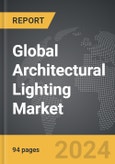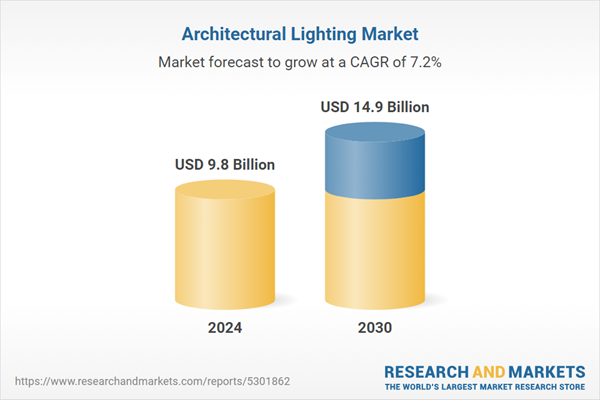Global Architectural Lighting Market - Key Trends and Drivers Summarized
Why Is Architectural Lighting Essential in Shaping Aesthetic and Functional Spaces?
Architectural lighting is a critical element in modern design, serving both aesthetic and functional purposes by enhancing the way spaces are perceived and used. It involves the strategic placement and specification of lighting systems to highlight architectural elements, create mood, and improve the functionality of interior and exterior spaces. From residential homes to commercial buildings, museums, and public spaces, architectural lighting helps define the character of a space. It goes beyond simply illuminating a room; it enhances textures, emphasizes structural features, and draws attention to specific design elements. Whether used to create dramatic effects with shadow and light or to provide balanced illumination for safety and functionality, architectural lighting is integral to how a space is experienced. Modern projects rely heavily on lighting as a key component to influence the user's interaction with the environment, making it an indispensable part of contemporary architectural practices. Furthermore, the integration of lighting design with the architecture itself ensures that the lighting complements the structure rather than being an afterthought, resulting in cohesive and dynamic environments.How Are Technological Advances Changing the Face of Architectural Lighting?
In recent years, technological advancements have drastically transformed architectural lighting, expanding its potential and application. One of the most significant innovations has been the development of LED (Light Emitting Diode) technology, which has become the dominant choice in architectural lighting due to its energy efficiency, longevity, and versatility. LED lights offer greater control over light intensity, color temperature, and directionality, enabling designers to create highly customized lighting schemes that were previously unattainable with traditional lighting systems. Additionally, the rise of smart lighting and IoT (Internet of Things)-enabled systems allows for more sophisticated lighting control. These systems enable automated, sensor-driven adjustments based on occupancy, daylight levels, or time of day, offering both energy savings and enhanced user comfort. Furthermore, advancements in dynamic lighting systems, which can change color and intensity in response to external factors, are being used to create immersive and responsive environments in public spaces, hotels, and retail establishments. The miniaturization of lighting components has also opened up new design possibilities, allowing for the seamless integration of lighting into architectural elements like ceilings, walls, and floors. These technological advancements are making architectural lighting more sustainable, efficient, and adaptable to the unique needs of different environments, driving innovation in design.What Are the Challenges and Opportunities in Architectural Lighting Design?
While architectural lighting presents many opportunities for creative and functional innovation, it also comes with its set of challenges. One of the major hurdles is balancing energy efficiency with aesthetic goals. As environmental concerns push for greener solutions, designers and architects must ensure that their lighting designs meet sustainability standards without compromising on the quality and visual appeal of the lighting scheme. This is especially true for large-scale projects like urban landscapes or commercial buildings, where lighting must be powerful yet energy-efficient. Additionally, ensuring uniformity and consistency in lighting across complex architectural forms can be difficult, particularly when working with unconventional shapes or materials that may reflect or absorb light in unpredictable ways. The integration of lighting into the architecture also requires a deep understanding of both the lighting technologies and the structural elements to ensure that the lighting enhances the design rather than detracting from it. However, these challenges also present vast opportunities for innovation. Adaptive lighting solutions, which adjust based on user needs or environmental conditions, are emerging as a key trend in the industry, providing both functional and aesthetic benefits. Furthermore, the growing demand for sustainable, human-centric lighting, which considers the impact of lighting on human health and well-being, is opening up new avenues for design, particularly in office spaces, healthcare environments, and educational institutions where lighting can significantly influence productivity, mood, and overall wellness.What's Fueling the Growth of the Architectural Lighting Market?
The growth in the architectural lighting market is driven by several key factors that align with both technological advancements and changing design philosophies. One of the primary drivers is the increasing demand for energy-efficient lighting systems, particularly in the context of global sustainability goals. Governments and organizations are pushing for greener buildings, which has led to a rise in the adoption of LED lighting and smart lighting systems that consume less energy while providing high-quality illumination. The expansion of urbanization and infrastructure development across the world is another major growth driver. As cities grow, so does the need for architectural lighting in public spaces, commercial buildings, and residential complexes. The trend towards smart cities is also fueling demand for connected, sensor-driven lighting systems that can be monitored and controlled remotely, optimizing both performance and energy use. Moreover, the growing focus on biophilic design - which seeks to integrate natural elements like light into architecture to enhance well-being - is contributing to the increased use of dynamic, naturalistic lighting in architectural projects. In commercial spaces, there is a heightened emphasis on branding and customer experience, driving the need for creative lighting solutions that help businesses differentiate their spaces and engage customers through immersive lighting environments. Lastly, advances in lighting control systems and software integration are making it easier for designers and architects to implement complex, multi-layered lighting designs that enhance both the functionality and aesthetics of a space. These drivers are collectively pushing the architectural lighting market forward, creating a landscape where innovation and sustainability coexist to shape the built environment.Report Scope
The report analyzes the Architectural Lighting market, presented in terms of market value (US$ Thousand). The analysis covers the key segments and geographic regions outlined below.- Segments: Light Type (Light Emitting Diode, High Intensity Discharge, Other Light Types); Application Area (Indoor, Outdoor); End-Use (Commercial, Residential).
- Geographic Regions/Countries:World; United States; Canada; Japan; China; Europe (France; Germany; Italy; United Kingdom; Spain; Russia; and Rest of Europe); Asia-Pacific (Australia; India; South Korea; and Rest of Asia-Pacific); Latin America (Argentina; Brazil; Mexico; and Rest of Latin America); Middle East (Iran; Israel; Saudi Arabia; United Arab Emirates; and Rest of Middle East); and Africa.
Key Insights:
- Market Growth: Understand the significant growth trajectory of the Light Emitting Diode Light segment, which is expected to reach US$7.4 Billion by 2030 with a CAGR of a 8%. The High Intensity Discharge Light segment is also set to grow at 6.9% CAGR over the analysis period.
- Regional Analysis: Gain insights into the U.S. market, valued at $2.5 Billion in 2024, and China, forecasted to grow at an impressive 11% CAGR to reach $3.7 Billion by 2030. Discover growth trends in other key regions, including Japan, Canada, Germany, and the Asia-Pacific.
Why You Should Buy This Report:
- Detailed Market Analysis: Access a thorough analysis of the Global Architectural Lighting Market, covering all major geographic regions and market segments.
- Competitive Insights: Get an overview of the competitive landscape, including the market presence of major players across different geographies.
- Future Trends and Drivers: Understand the key trends and drivers shaping the future of the Global Architectural Lighting Market.
- Actionable Insights: Benefit from actionable insights that can help you identify new revenue opportunities and make strategic business decisions.
Key Questions Answered:
- How is the Global Architectural Lighting Market expected to evolve by 2030?
- What are the main drivers and restraints affecting the market?
- Which market segments will grow the most over the forecast period?
- How will market shares for different regions and segments change by 2030?
- Who are the leading players in the market, and what are their prospects?
Report Features:
- Comprehensive Market Data: Independent analysis of annual sales and market forecasts in US$ Million from 2024 to 2030.
- In-Depth Regional Analysis: Detailed insights into key markets, including the U.S., China, Japan, Canada, Europe, Asia-Pacific, Latin America, Middle East, and Africa.
- Company Profiles: Coverage of players such as Acuity Brands Lighting, Inc., Cooper Industries PLC, Cree Inc., Cree Lighting, Epistar Corporation and more.
- Complimentary Updates: Receive free report updates for one year to keep you informed of the latest market developments.
Some of the 43 companies featured in this Architectural Lighting market report include:
- Acuity Brands Lighting, Inc.
- Cooper Industries PLC
- Cree Inc.
- Cree Lighting
- Epistar Corporation
- Feilo Sylvania
- Galaxia
- GE Lighting LLC
- General Electric Company
- GRIVEN S.r.l.
- OSRAM GmbH
- Osram Licht AG
- Philips Lighting Holding B.V.
- Samsung Electronics
- Seoul Semiconductor Co., Ltd
- Signify Holding
- TCP International Holdings Ltd.
- Toshiba Lighting & Technology Corporation
- Verbatim Ltd.
This edition integrates the latest global trade and economic shifts into comprehensive market analysis. Key updates include:
- Tariff and Trade Impact: Insights into global tariff negotiations across 180+ countries, with analysis of supply chain turbulence, sourcing disruptions, and geographic realignment. Special focus on 2025 as a pivotal year for trade tensions, including updated perspectives on the Trump-era tariffs.
- Adjusted Forecasts and Analytics: Revised global and regional market forecasts through 2030, incorporating tariff effects, economic uncertainty, and structural changes in globalization. Includes historical analysis from 2015 to 2023.
- Strategic Market Dynamics: Evaluation of revised market prospects, regional outlooks, and key economic indicators such as population and urbanization trends.
- Innovation & Technology Trends: Latest developments in product and process innovation, emerging technologies, and key industry drivers shaping the competitive landscape.
- Competitive Intelligence: Updated global market share estimates for 2025, competitive positioning of major players (Strong/Active/Niche/Trivial), and refined focus on leading global brands and core players.
- Expert Insight & Commentary: Strategic analysis from economists, trade experts, and domain specialists to contextualize market shifts and identify emerging opportunities.
Table of Contents
Companies Mentioned (Partial List)
A selection of companies mentioned in this report includes, but is not limited to:
- Acuity Brands Lighting, Inc.
- Cooper Industries PLC
- Cree Inc.
- Cree Lighting
- Epistar Corporation
- Feilo Sylvania
- Galaxia
- GE Lighting LLC
- General Electric Company
- GRIVEN S.r.l.
- OSRAM GmbH
- Osram Licht AG
- Philips Lighting Holding B.V.
- Samsung Electronics
- Seoul Semiconductor Co., Ltd
- Signify Holding
- TCP International Holdings Ltd.
- Toshiba Lighting & Technology Corporation
- Verbatim Ltd.
Table Information
| Report Attribute | Details |
|---|---|
| No. of Pages | 370 |
| Published | November 2025 |
| Forecast Period | 2024 - 2030 |
| Estimated Market Value ( USD | $ 9.8 Billion |
| Forecasted Market Value ( USD | $ 14.9 Billion |
| Compound Annual Growth Rate | 7.2% |
| Regions Covered | Global |









